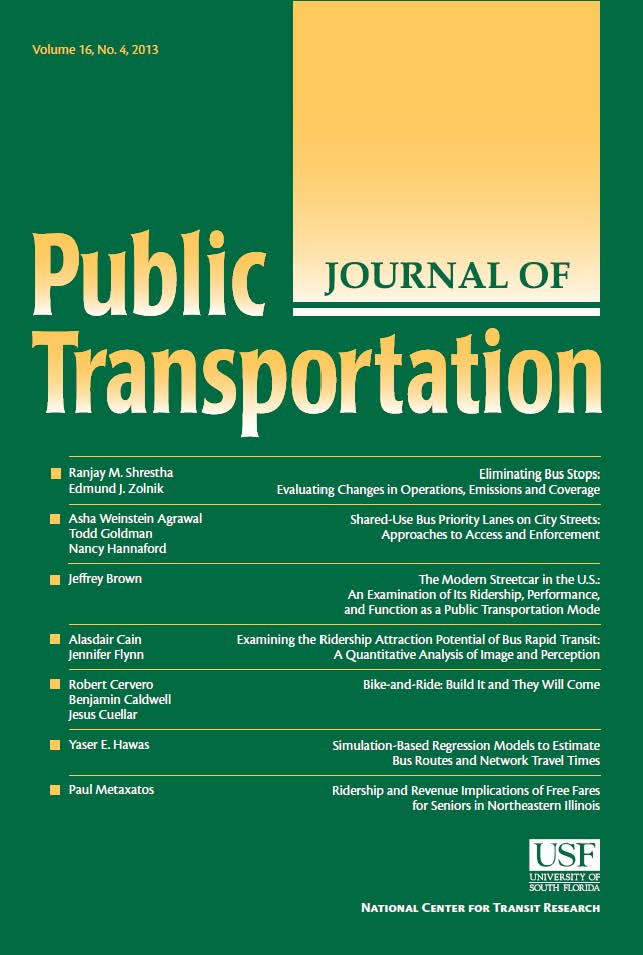监测公共交通拥挤暴露:斯德哥尔摩在2019冠状病毒病大流行之前、期间和之后
IF 2
4区 工程技术
Q3 TRANSPORTATION
引用次数: 0
摘要
公共交通工具的拥挤暴露对乘客的出行体验产生了严重的负面影响。特别是在2019冠状病毒病大流行期间,暴露在拥挤的环境中也可能增加乘客之间病毒传播的风险。为了减轻拥挤对公共交通系统的负面影响,越来越需要了解拥挤暴露在服务区域和乘客群体中的分布情况,以及它如何随时间变化。本文提供了一种方法来监测公平性拥挤暴露随着时间的推移使用纵向智能卡数据。提出了一种量化拥挤暴露的客观度量:相对拥挤旅行时间(rCTT)。我们应用洛伦兹曲线、基尼系数和Suits系数来评估水平公平(整个人口)和垂直公平(考虑收入)。在我们对斯德哥尔摩地区的案例研究中,我们通过评估COVID-19大流行不同阶段(COVID-19前、COVID-19和COVID-19后)拥挤暴露的公平性来展示我们的方法。我们的研究结果表明,大流行对横向和纵向公平都产生了负面影响。在大流行期间,整个服务区的拥挤暴露变得越来越不均匀。虽然大流行期间总体客流量和拥挤程度有所下降,但不同社会群体的减少幅度并不一致。与高收入乘客相比,低收入乘客的出行减少幅度较小,导致弱势群体更容易受到拥挤的影响,并从渐进式分布向递减分布转变。这些发现强调了继续监测拥挤暴露的重要性,特别是在旅行行为和政策背景不断演变的情况下。拟议的框架可以帮助确定和瞄准最关键的公平差距,使干预措施更加集中和有效。低收入的旅行者比高收入的旅行者更拥挤。然而,到了新冠肺炎后阶段,拥挤暴露的公平性几乎恢复到新冠肺炎前的水平。本文章由计算机程序翻译,如有差异,请以英文原文为准。
Monitoring public transport crowding exposure: Stockholm before, during, and after the COVID-19 pandemic
Crowding exposure in public transport vehicles has a serious negative impact on passengers’ travel experience. Especially during the COVID-19 pandemic, exposure to crowded conditions may also increase the risk of virus transmission among passengers. To mitigate the negative impact of crowding on public transport systems, there is an increasing need to understand how crowding exposure is distributed across the service area and passenger groups, and how it changes over time. This paper provides a methodology for monitoring the equity of crowding exposure over time using longitudinal smart card data. An objective measure is proposed to quantify crowding exposure: relative crowded travel time (rCTT). We apply Lorenz curves, Gini and Suits coefficients to assess horizontal equity (across the population) and vertical equity (considering income). In our case study of the Stockholm Region, we demonstrate our method by assessing the equity of crowding exposure during different stages of the COVID-19 pandemic: pre-COVID, COVID, and post-COVID. Our findings show that the pandemic negatively impacted both horizontal and vertical equity. During the pandemic, crowding exposure became increasingly uneven across the service area. While overall ridership and crowding exposure declined during the pandemic, reductions were not uniform across social groups. Lower-income riders showed smaller decreases in travel compared to higher-income riders, resulting in greater crowding exposure among disadvantaged groups and a shift from a progressive to a regressive distribution. These findings reinforce the importance of continued monitoring of crowding exposure, especially as travel behavior and policy contexts continue to evolve. The proposed framework can help identify and target the most critical equity gaps, enabling more focused and effective interventions.with lower-income travelers experiencing more crowding than their higher-income counterparts. However, by the post-COVID stage, the equity of crowding exposure has nearly returned to pre-COVID levels.
求助全文
通过发布文献求助,成功后即可免费获取论文全文。
去求助
来源期刊

Journal of Public Transportation
TRANSPORTATION-
CiteScore
6.40
自引率
0.00%
发文量
29
审稿时长
26 days
期刊介绍:
The Journal of Public Transportation, affiliated with the Center for Urban Transportation Research, is an international peer-reviewed open access journal focused on various forms of public transportation. It publishes original research from diverse academic disciplines, including engineering, economics, planning, and policy, emphasizing innovative solutions to transportation challenges. Content covers mobility services available to the general public, such as line-based services and shared fleets, offering insights beneficial to passengers, agencies, service providers, and communities.
 求助内容:
求助内容: 应助结果提醒方式:
应助结果提醒方式:


